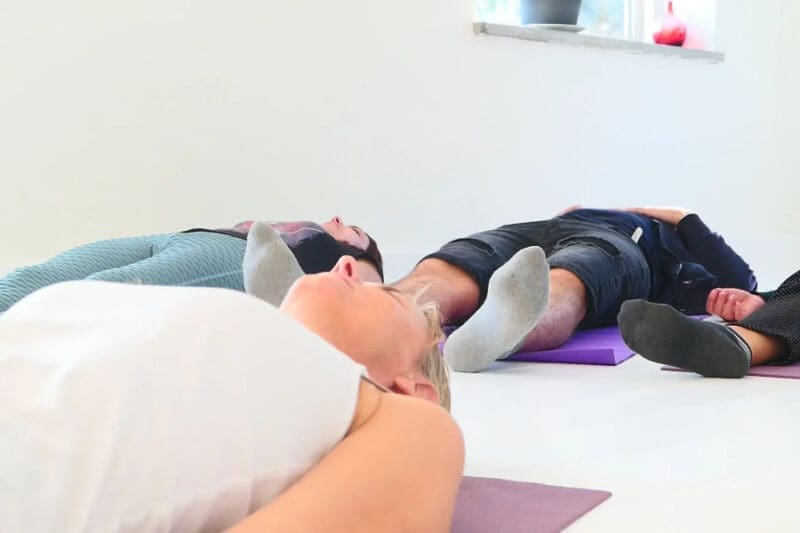The vagus nerve could be what the ancient sages saw from the depths of samadhi. The image of a fiery serpent running up the spine fits well with our understanding of how the electrical impulses of the vagus nerve light up the body.
The Mind Body Connection
The vagus nerve is an extended structure that connects our brain to what is happening in the body. It is literally the mind-body connection and key to improved well-being.
What is the vagus nerve?
It is called “vagus” because, like a vagrant, it wanders from the brain stem out into the body and among the organs. Although described as a single nerve, it is actually two bundles of fibers, one for each side of the body. The many sensory fibers provide feedback from the main organs (gut, heart, spleen etc.) to the brain. In this way, the brain knows the status of each organ, literally how we are feeling, and can modulate our response to stress and illness.
The parasympathetic nervous system
The vagus nerve also oversees a vast array of crucial functions, communicating motor and sensory impulses to every organ in your body. It’s main role is to control of the parasympathetic nervous system, the system responsible for our relaxation response. It counteracts the fight-or-flight response of the sympathetic nervous system.
In today’s world it is impossible to completely avoid stress. However, instead of being unsettled for a long time, we can more quickly return to feeling safe and relaxed. The vagus nerve is one of the most complex neural highways in the body and is critical to managing stress. In particular, how quickly we recover from episodes of stress.
Given the vagus nerve controls vital body functions, such as heart rate and blood pressure, breathing and inflammation, this takes on additional and significant importance. By activating and toning the nerve we can improve and protect body functions important for our well-being.

Balancing fight or flight
When we experience sudden, high stress, we activate a stress response, also called fight-or-flight. The body prepares to either run away or stay and fight. This reaction evolved to help us survive, enabling us to react quickly to life-threatening situations. These days, though, we rarely come across predators or enemies in our workplace or homes. Instead, things like looming deadlines, traffic jams and relationship difficulties trigger the stress response.
During periods of high stress, the hormones adrenaline and cortisol are present at high levels in the body. This exhausts and damages both body and mind. Long-term stress creates an array of health problems from chronic pain, anxiety and mood swings to gut inflammation and insomnia, and many more. The good news is, the vagus nerve is our inbuilt containment device that lowers our fight-or-flight response. It triggers a physical counter-balance, the relaxation response. And by stimulating it we get powerful health benefits.
The more things we can do to relax, such as deep breathing or yoga, the more we banish the effects of our “fight or flight” response. The result is lower stress hormones like adrenaline and cortisol and a happier, more relaxed state of being.
The vagus nerve, chakras and kundalini
The practice of yoga, especially kundalini yoga, aims to awaken kundalini. Kundalini is often depicted as a serpent coiled around the base of the spine, in the Muladhara chakra. The effects of a kundalini awakening include a higher sense of life, creativity, and fulfilment of our potential. When awakened, kundalini moves up the spine, purifying and opening each of the seven chakras in turn. Its final destination, the crown chakra (sahasrara) located at the top of the head, results in full spiritual awakening.
The vagus nerve could very well be what the ancient sages saw from the depths of samadhi, as described in the vedas. The image of a fiery serpent running up the spine fits well with our understanding of how the electrical impulses of the vagus nerve light up the body, travelling mostly upwards toward the brain. Travelling from the colon to the brain, it maps the same pathway taken by kundalini from Muladhara to crown chakra. We can consider it to be the physical manifestation of (or perhaps the vehicle for) the life-force energy known as kundalini shakti.
Knowing how to strengthen and activate this vital nerve through yoga, and access it’s power, equips us with very real techniques to improve our well-being, increase energy and more fully realise our true potential. It also, of course, includes the possibility of something much, much greater.
How the chakras and vagus nerve align
First identified in the ancient Sanskrit vedas, chakras are described as like a wheel or disk of spinning energy. These energy points correspond physically to nerve bundles, major organs and endocrine glands.

1. Minds eye chakra
The vagus nerve is the main pathway for conveying information about the internal condition of the body to the brain. The scientific term for this is interoception.
The numerous strands of information relayed by the vagus nerve are processed in the brain. This not only provides insight (consciously or not) about our internal body processes, but is central to a range of cognitive and emotional processes, including memory, decision-making, emotional processing, social interactions, and even consciousness, body ownership and our sense of self.
2. Throat chakra
The vagus nerve branches in the throat. One branch (the recurrent laryngeal nerve) controls voice production, and the other (superior dorsal nerve) is involved in swallowing (and tells us when we have a sore throat).
Your voice box (larynx) is connected to your vagus nerve. Subsequently, when you hum, sing or chant, you naturally activate it. It’s worth noting that long deep tones, ones that engage the diaphragm as well as the vocal cords, appear to have a profoundly activating effect on the vagal system.
3. Heart chakra
The vagus nerve affects heart rate. Electrical impulses sent to a specialized muscle tissue in the heart (the atrioventricular node) release acetylcholine. This, in turn, slows the pulse and lowers blood pressure. In essence, the vagus acts as the heart’s natural pacemaker.
The vagus also connects to the diaphragm and helps you breathe. Importantly, stretch receptors in the lungs send signals back to the brain along the vagus nerve, creating a feedback loop. As a result, breathwork (such as deep abdominal breathing) is one of the most powerful and accessible methods used to activate the vagal system.
4. Power Chakra
In the gut, the vagus nerve increases digestive juice secretion, stomach acidity, and gut flow. After a meal, relaxation and “fullness” is mediated by the vagus sending signals to the brain in response to food intake.
Managing anxiety levels is one the key functions of the vagus nerve, allowing us to relax and feel more confident. One of the main ways you can stimulate the healthy function of the vagus is through deep, slow belly breathing.
5. Sacral chakra
The vagus nerve connects to a woman’s cervix, uterus, and vagina. It helps control orgasm and fertility. The vagus nerve also regulates the release of testosterone and oxytocin (the so-called love hormone).
6. Root chakra
Stress inihibits the signals sent through the vagal network, and also causes gastrointestinal problems. One study found people with irritable bowel syndrome (IBS) or Crohn’s disease had lower vagal tone, indicating a reduced function of the vagus nerve.
By connecting your gut to your brain, your gut uses the vagus nerve to tell your brain how you’re doing. Your “gut feelings” are very real.

Connecting Inner And Outer
The vagus nerve plays a central role in how we perceive and respond to the world around us, via two pathways.
- The dorsal motor nucleus carries messages about the outside world from your brain to your internal organs. This allows us to regulate processes like breathing and digestion.
- The ventral vagus network, centered around the throat chakra, controls speech, voice, and facial expression. In other words, how we present ourselves to the world through social cues.
In short, this remarkable nerve acts to harmonise our inner and outer world, and connects our thoughts to our feelings.
The importance of breath
It is worth knowing that it is specifically the exhale that triggers the relaxation response.
Vagus nerve activity is highest, and the heart rate lowest, when you are exhaling.
Research indicates the most calming way to breathe is to take six breaths per minute. That’s five seconds in, five seconds out.
Interestingly, this is the exact same rate people naturally adopt when chanting mantras such as Om mane padme hum and the Ave Maria prayer with rosaries. Accordingly, these practices have evolved and become widely adopted, at least in part, because they fit this naturally relaxing frequency.
Yoga For The Vagus Nerve
Now you know the benefits of a healthy vagus nerve, you might be keen to know how to activate it. After all, who wouldn’t want some of its promised health-giving powers? A healthy vagus nerve helps us feel relaxed, calm, grounded and better able to effectively navigate life.
The Ashram Blog will be writing a follow-up article called Yoga for the Vagus Nerve. Follow the link to read about breathing practices, yoga asanas, kundalini kriyas and meditations to tone and activate your vagus nerve.
References
- Tom Seymour, Everything You Need To Know About The Vagus Nerve, 26 Jun 2023, from MedicalNewsToday.
- Jill Seladi-Schulman, Ph.D., What Is The Vagus Nerve, 14 Feb 2023, from Healthline.
- The Relaxation Response, from Wikipedia.
- Kendra Cherry MSEd, What Is The Fight Or Flight Response, 07 Nov 2022, from Verywellmind.
- Edith Zimmerman, I Now Suspect The Vagus Nerve Is Key To Wellbeing, 09 May 2019, from The Cut.



 November 26, 2024
November 26, 2024 
